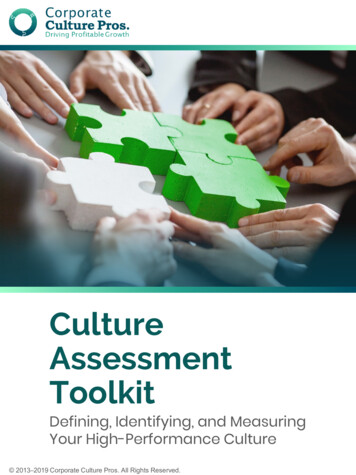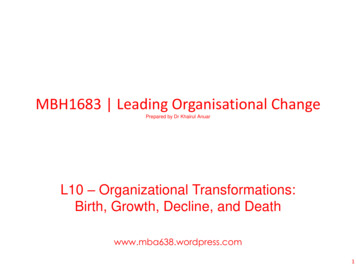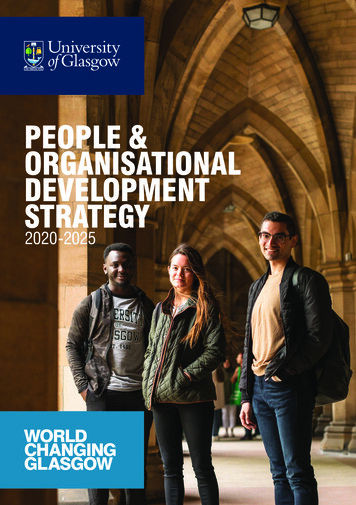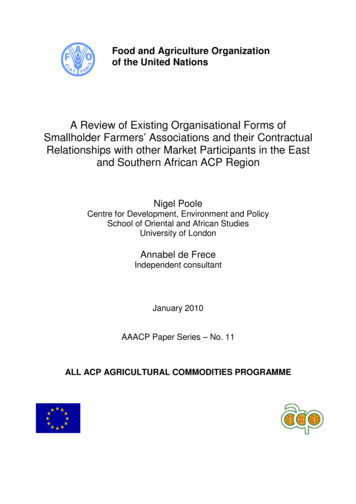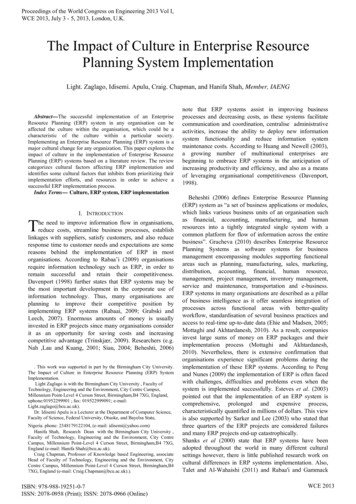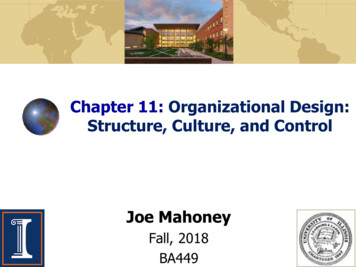
Transcription
Understanding and ManagingOrganisational Culture
CPMR Discussion Paper40Understanding and ManagingOrganisational CultureOrla O’DonnellRichard Boyle
First published in 2008by theInstitute of Public Administration57-61 Lansdowne RoadDublin 4Irelandin association withThe Committee for Public Management Researchwww.ipa.ie 2008 with the Institute of Public AdministrationAll rights reserved. No part of this publication may bereproduced or transmitted in any form or by any means,electronic or mechanical, including photocopying, recordingor any information storage and retrieval system, withoutpermission in writing from the publisher.British Library Cataloguing in Publication DataA catalogue record for this book is available from the BritishLibrary.ISBN: 978-1-904541-75-2ISSN: 1393-6190Cover design by Creative Inputs, DublinTypeset by the Institute of Public AdministrationPrinted by ColourBooks Ltd, Dublin
CONTENTSAcknowledgmentsviiExecutive SummaryviiiChapter 1: Introduction1.1 Background1.2 Policy context1.3 Terms of reference and study approach1.4 Report structureChapter 2: Organisational culture: lessons from theliterature2.1 Introduction2.2 What is organisational culture?2.3 Types of organisational culture2.4 Why is culture important?2.5 Issues in managing culture2.6 ConclusionChapter 3: International public and private sectorexamples of culture management3.1 Introduction3.2 Australia: Culture change in the Queenslandpublic sector3.3 Canada3.4 United Kingdom3.5 USA3.6 Hong Kong and Shanghai Banking Corporation3.7 3M3.8 Conclusions11123444691314161616202123243135Chapter 4: Irish public service experience with culturemanagement374.1 Introduction374.2 Three central government organisations38v
4.3 Two public sector agencies4.4 Three local authorities4.5 Key chapter findings455159Chapter 5: Conclusions and recommendations5.1 Introduction5.2 What is culture? The concept of culture revisited5.3 Why is culture an important issue for public servicemanagers?5.4 What can managers do to influence/shape culture?5.5 Conclusion646464Appendix 174Appendix 282References88vi656772
ACKNOWLEDGMENTSThis study on Understanding and Managing OrganisationalCulture could not have been completed successfully withoutthe active support and co-operation of officials in a numberof public service organisations. Special thanks are due toBrigid McManus, (Secretary General, Department ofEducation and Science); Catherine Treacy (Chief Executive,Property Registration Authority); Dr. Ciaran Kissane,(Director of Corporate Services, Broadcasting Commissionof Ireland); Joe Crockett, (formerly County Manager, CarlowCounty Council and at present County Manager of KilkennyCounty Council); Phil Furlong, (former Secretary General,Department of Arts, Sport and Tourism); Michael McLoone(County Manager, Donegal County Council) and SeanSheridan (Director of Corporate Services, Donegal CountyCouncil); Frank Daly (formerly Chairman, The Office of theRevenue Commissioners and at present Chairperson of theCommission on Taxation) and Joe Horan (County Manager,South Dublin County Council) who provided wholeheartedsupport to the in-depth case-study analysis of theirrespective organisations. In addition, the informationprovided by members of the Committee for PublicManagement Research and Dr. Paul Mc Grath and Mr.Charles Geaney, UCD Michael Smurfit School of Business,proved very helpful.Responsibility for the content of the paper, however, restswith the authors.Orla O’DonnellRichard BoyleJune 2008vii
EXECUTIVE SUMMARYIntroductionOrganisational culture is a widely used term but one thatseems to give rise to a degree of ambiguity in terms ofassessing its effectiveness on change variables in anorganisation. For the past number of decades, mostacademics and practitioners studying organisations suggestthe concept of culture is the climate and practices thatorganisations develop around their handling of people(Schein, 2004). Watson (2006) emphasises that an importanttrend in managerial thinking in recent decades has been oneof encouraging managers to try to create strongorganisational cultures. Schein (2004) suggests that cultureand leadership are conceptually intertwined. This issupported by O’Farrell (2006) in his analysis of theAustralian public service, where he concludes that‘statements of values, codes of conduct, principles of publicservice management and so on set out in rules andregulation are simply rhetoric or what we now callaspirational statements. Without leadership that is what theywill ever be rhetoric. It is our job as administrators, managersand leaders to turn them into reality’ (O’Farrell, 2006. p.8).This study reviews evidence that shows why managingculture is important to effectively enhancing bothorganisation performance and, in macro terms, the publicservice modernisation programme. Based on the nationaland international literature reviewed and interviewsconducted, guidance is provided in relation to moreeffectively managing culture, and issues to be addressed interms of its effective engagement and use in the publicservice are outlined.Why is culture an important issue for public servicemanagers?Why should public service managers concern themselveswith culture? Will it make any difference at the end of theday to know what type of culture or subcultures exist in anorganisation, what cultural traits may be desired, and soon?For managers with busy schedules, is culturesomething they should be concerned with?viii
The evidence presented here, from the literature,international studies and the Irish experience, suggeststhat culture is indeed something that public servicemanagers should pay attention to. First and foremost, thisis because culture affects the performance of organisations.In the private sector organisations studied The Hong Kongand Shanghai Banking Corporation and 3M there is aclear and explicit link between culture change andperformance. But this can also be the case in the publicsector, despite the absence of a ‘bottom line’. Ban’s (1995)study of the good performance of the US EnvironmentalProtection Agency compared to other federal agencies, citedin Chapter 2, shows how culture can affect performance.The Irish cases studied, such as the BroadcastingCommission of Ireland (BCI) and the Property RegistrationAuthority (PRA) would also suggest that attention paid toculture influences performance in a positive manner.The evidence from this study would also suggest that itis particularly important for managers to pay attention toculture when reacting to or planning major organisationalchange. Culture is particularly important when anorganisation is undergoing significant transformation orwhen introducing major reforms which require different ornew cultural or value traits from those exhibited in the past.What can managers do to influence/shape culture?Knowing that culture is important in shapingorganisational practice and performance in public sectororganisations is one thing. But a subsequent issue is theextent to which managers can actually shape or influenceculture. The literature on culture change explored inChapter 2 is somewhat ambivalent on this point. On theone hand, examples can be identified where interventionscan influence culture. But on the other hand, someacademics warn of the danger of attempting to influence themore superficial aspects of culture such as symbols andceremonies, while ignoring the more pervasive and deepseated aspects of culture such as values and beliefs. Thesemore deep seated aspects of culture are much more difficultto influence.ix
Six key issuesBased on the academic literature in this study and thefindings from the interviews, Chapter 5 sets out aframework that identifies six key issues that managers needto address in order to contribute to creating a moredevelopmental and performance oriented culture in theirorganisation. These issues are as follows:1. Creating a climate for changeIn terms of creating a climate for change, culture is onlyeffective if it is applied to the relevant area needing changeor is tied to some organisational issue. Several of theorganisations studied here used internal or external driversin order to facilitate the culture shift they wanted to seeachieved.For example, the UK civil service at the‘unfreezing’ stage of their change programme created aclimate where civil service change to a more managerialculture was seen as required in order to address longstanding problems. The Department of Education andScience uses the social partnership agreements as aframework within which to promote change. BCI has usedits organisational development policy as the driver fordeveloping the organisation’s culture in the desireddirection.2. Leaders as championsLeadership is clearly important in determining theeffectiveness of culture change. The leaders of organisationsare ‘champions’ of understanding and managing culture inthe organisation and of rewarding or punishing subculturesdepending on whether they align or not with the corporateculture espoused by the leaders. The influence of leaders interms of rewarding the sub-culture groups that espouse thedominant beliefs, values and underlying assumptions of theorganisation cannot be underestimated. This isdemonstrated, for example, in Queensland Health, 3M andthe Department of Arts, Sport and Tourism wheresignificant emphasis has been put on leadershipdevelopment programmes and initiatives. The localauthority examples illustrate that clear strategic leadershipis necessary to ensure the consistency of organisationculture.x
3. Employee engagement and empowermentEmployee engagement and empowerment is crucial toensure that the culture is effectively managed and alignedwith the cultural assumptions of the organisation as awhole. Demonstration projects in the UK civil service, whichpromoted the desired managerial thinking and at the sametime engaged staff in the change process, were an importantelement in cultural change. Local partnership committeesand projects in BCI and the PRA have been used to engageand empower staff, though each recognises thatpartnership arrangements need careful management if theyare to be successful.4. Team orientationTeam working was a common feature in most organisationsstudied, in terms of crossing existing barriers and as auseful means of promoting and disseminating new culturaltraits. In terms of individual and organisationaldevelopment, teams are seen as a way of investing in talentdevelopment. HSBC, for example, put particular emphasison team projects rooted in the promotion of the desired corevalues for the organisation. The Carlow County Councilcase highlights a further dimension of team orientation the benefits of developing joint team working withindividuals and businesses outside the organisation to helpshift the focus to the promotion of a developmental culture.Similarly, Carlow County Council, Donegal County Counciland South Dublin County Council emphasise a culture ofcross-agency and cross-functional collaboration andteamwork with public bodies and agencies in developingmore effective provision of services at a local level.5. Tracking cultural changeTracking cultural change is important in terms of assessingwhether the culture has become misaligned in terms of subgroup cultures’ practices, or whether there are issues orchallenges to be addressed which could undermine thecultural ethos and underlying assumptions of theorganisation. In the US, the Organisational CultureAssessment Instrument (OCAI) has been used to good effectin some federal agencies. BCI undertook an organisationalculture mapping exercise. Schein (2004) suggests that thexi
ten-step Culture Awareness Programme (see Appendix 1 fordetails) is a helpful instrument in most situations in whichleaders need to manage some element of their culture.6. Training, rewards and recognitionTraining in terms of culture awareness is viewed differentlyin various organisations. Culture is an aspect of generalmanagement training in some organisations. In otherorganisations, it is deemed appropriate to learn fromleaders and managers about the prevalent cultural normsand assumptions. 3M has placed as much emphasis onnon-monetary rewards such as honours and recognitionprogrammes as it has on monetary rewards. Carlow CountyCouncil, similarly, has placed significant emphasis onrecognition and reward and particularly encouragingentering national recognition and reward schemes as a wayof promoting a winning culture.Concluding remarksThis study seeks to enhance understanding in relation toeffectively managing culture in public sector organisationsand also to provide lessons from initiatives implemented todate in both the public and private sectors. The importanceof managing and manipulating culture in public sectororganisations cannot be underestimated in terms of itsimpact on the modernisation agenda. Developingappropriate measures to address culture issues inorganisations in terms of increasing organisationalcapability and performance are addressed in earlierchapters of this study. While the implications of suchapproaches are wide-ranging, fundamentally the key toeffective culture management is leadership. Leadershipmust be committed to managing culture in terms ofdeveloping and sustaining organisational performance,while managers throughout the organisation areresponsible for its effective development.There is much that remains to be done to address theevident gap between the impact of cultural issues and theapproaches adopted by managers, approaches which arequite rudimentary in many public sector organisations. Theorganisations cited for this study provide useful examples ofhow organisations can effectively manage organisationculture as an integral part of both corporate strategies andxii
organisational change measures to enhance performanceand innovation. This study contributes to the awarenessand understanding of culture management in public
In the US, the Organisational Culture Assessment Instrument (OCAI) has been used to good effect in some federal agencies. BCI undertook an organisational culture mapping exercise. Schein (2004) suggests that the xi. ten-step Culture Awareness Programme (see Appendix 1 for details) is a helpful instrument in most situations in which leaders need to manage some element of their culture. 6 .

